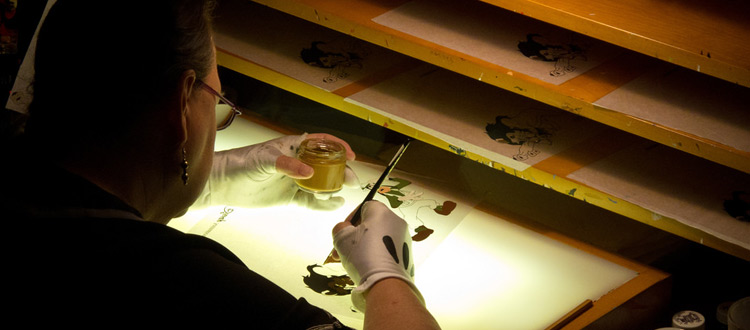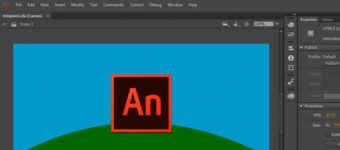
Best 2D Animation Books: The Ultimate Collection
Classic 2D animation has dipped from mainstream films in recent years with some claiming it’s dead.
But there are tons of viewers who still prefer 2D and it’s an art form with only a century’s worth of history. Some companies like Disney have officially stopped 2D films and will only use 2D for television animation.
With that said there’s still plenty of room to develop a 2D skillset and thrive in the animation industry.
The toughest part is learning to animate well, and in this post I’ve curated the largest collection of books teaching classic 2D animation principles. If you’ve ever wanted to learn then here’s a treasure trove of resources to get started.
The Animator’s Survival Kit


If there’s any book that every animator should own it’s The Animator’s Survival Kit.
This is a no question must-have resource covering basically every single subject about animation. You’ll learn about timing, pacing, motion, weight, posing, and all the 12 basic principles of animation.
Even professional animators keep a copy of this book nearby. It’s an incredible resource and it should be a staple in your animation journey.
It is fairly dense so you might not find much use for it right away. But in time as your skills improve you’ll be able to reference this guide over and over again with consistent success.
Timing for Animation


As a follow-up to the survival kit I also recommend nabbing a copy of Timing for Animation.
This book is a lot shorter and smaller with only 174 pages. But it dives right into the content about timing for animated films, TV shows, and more general open-ended questions about timing for any animated work.
You’ll learn how to map exposure sheets which are incredibly common in 2D animation. Later chapters cover specific details about animating slow objects, heavy people/objects, walk cycles, lip syncs, and pretty much everything you’d need to know.
This is another must-have resource but it’s primarily aimed at skilled professionals.
If you’re just starting out with 2D animation then skip this for now. But remember this book for later because it’ll help you understand timing to apply it accurately to your work!
Sketching for Animation


Sketching for Animation is one of the newest books in this list and it’s such a cool resource. Over 350 pages you’ll learn exercises and tips to apply into your sketching workflow.
Animators need to be fast yet accurate. This requires incredible discipline and a deep study of how the natural laws of physics operate(weight, movement, force, etc).
Author Peter Parr cites many examples from his animation classes along with resources from other professional animators. You’ll learn proper form design and exercises to improve the quality of your sketches in a very short timeframe.
Featured animators interviewed for this book include the legendary Glen Keane, Tori Davis, and John Canemaker. They share tips for creating realistic three-dimensional shapes with just a simple pencil.
While this is still a very new book it’s also one of the better resources for beginners. It doesn’t cover the act of animating but it does teach you how to think and draw like an animator.
The Illusion of Life


No list could be complete without mentioning The Illusion of Life. This massive compendium of 580 pages offers the deepest look into Disney’s animation history.
The authors Ollie and Frank are two of Disney’s nine old men that shaped the face of the studio’s animation style. There’s even a documentary about these guys covering their life and their contributions to many of Disney’s classic feature films.
The Illusion of Life shares sketches, layouts, character designs and lots of production artwork. But it also features prominent advice for aspiring animators about recording audio and capturing personality in the work.
No other animation studio has been able to do what Disney can do. And this book covers many of Disney’s oldest animation secrets, all of which come from the 2D animation boom in the mid 20th century.
If you’re a Disney fan then you’ll definitely love this book. If you want to study the works of animation masters then this book is worth reading many times over.
Character Animation Crash Course


Eric Goldberg is a more recent Disney animator working on films like Aladdin and Pocahontas. His book Character Animation Crash Course teaches everything you need to know about animating lifelike characters.
It’s just over 200 pages long and the contents are extremely technical. Eric defines all the major animation terms teaching readers about models and x-sheets along with 2D animation setups using animation desks.
This book isn’t a complete replacement for a college degree—but it’s damn close!
If you follow Eric’s advice and keep practicing life drawing on your own then you will see improvement in your animations.
Eric teaches you how to think like your character and animate them accurately. You have to get into their head and really become the character. This is the deepest truth behind all the greatest modern animators in history.
How to Make Animated Films


How to Make Animated Films should be a primary resource in your journey to master 2D animation. The author Tony White has over thirty years of experience working in the animation industry.
This book really is a complete masterclass on the fundamentals of animation. It comes with lots of free samples and DVDs with movies you can watch and replicate on your own.
But each chapter moves through the fundamentals at a slow pace covering every step along the way. You’ll learn how to mark key positions and how to structure inbetweening for each major position.
Each chapter works like its own masterclass where you’ll get a bunch of exercises and a final working project. The first couple chapters touch on the basics of movement and use the example of a bouncing ball, a common animation exercise.
The great thing about Tony’s book is that it’s dense and easy to read. If you can make it through all 500+ pages you will see a huge jump in your animation capabilities.
Producing Independent 2D Character Animation


If you can’t find a paying job in 2D you can always animate your own stuff for practice. Producing Independent 2D Character Animation is a goldmine of information to learn cel animation from scratch.
The author Mark Simon has over two decades of experience working under top animators in character design and storyboarding roles. This book teaches how to plan, coordinate, and animate individual shots.
You’ll learn how to map out a sequence of events and sketch every movement as part of the motion. Mark even shares tips along the way to help aspiring animators stand out from the crowd.
As if that wasn’t enough, this book also has tons of interviews with industry veterans like Craig McCracken(Powerpuff Girls creator) and Cartoon Network’s Senior VP of animation Linda Simensky.
With this book you can learn 2D animation, gain insight into how the industry works, and dig into the journey of skilled animators. If this doesn’t make your mouth water then I don’t know what will.
Acting for Animators


It may seem strange but animators have to think like actors on stage. 2D animation requires perfect flow and motion that feels lifelike.
Acting for Animators uses basic acting theory to teach animators how to accurately animate their characters. This includes motion, balance, posture, and facial expressions that match a character’s tone.
The process of acting varies depending on the medium. Animation differs greatly from theatre but the concepts still apply.
This book includes tons of illustrations and breakdowns of animated features examining the animation process. It’s a fantastic resource for skilled animators who want to up their game to the next level.
The Animator’s Eye


At first glance The Animator’s Eye might seem a bit redundant with other books in this list. However it offers a very unique glimpse into animation from the perspective of a 2D animator.
This book places emphasis on visual storytelling with volume, shape, light, and perspective. The goal is to train your eye to see properly and to build ideas from imagination.
Author Francis Glebas is also a skilled animator with decades of industry experience. He shares his personal insights with detailed topics including “cartoon” physics compared to real physics. His tips are easy to digest and made for aspiring animators.
Later in the book he also breaks down popular animated features to demonstrate why they work so well. This offers a deeper look into the animation process with the analysis of an expert.
Animation: 2D and Beyond


Animation: 2D and Beyond is not your ordinary animation book. It’s a compilation of 15 talented animators from all walks of life who share their knowledge about 2D animation.
You’ll get to read about very unique animation techniques with materials outside the usual cel animation. But you’ll also learn some fun techniques that you can replicate in your own work.
Thankfully this book is a bit dated so you can find copies for pretty cheap. However it is pretty large with about 175 pages and many different sections covering advice for aspiring animators.
These techniques can apply to hobbyist animators too. There are lots of tips for breaking into the industry but you can learn just as much about traditional animation through this guide.
Animated Performance


If you’re looking for a solid mix of tips + exercises then check out Animated Performance by Nancy Beiman. It’s currently in its 2nd edition spanning 250+ pages full of interviews, illustrations, and guided exercises.
Early chapters talk about the basics of character movement and how this works on the page. From there you’ll learn how to apply common techniques into your work like the line of action, consistent movements, and simultaneous actions which happen onscreen.
This really is a solid practical guide for 2D animators who want real exercises they can practice. Nancy offers her own take on the bouncing ball and flour sack animation exercises common to new 2D animators.
Many chapters include custom illustrations from Disney animators who share their process creating lifelike characters from scratch. This book has so much info that you’ll have to re-read it many times just to absorb everything.
Definitely a handy resource to keep on hand while animating.
Animation from Pencils to Pixels


There’s no denying the benefits of modern digital animation over cels and ink. But you can still practice 2D animation digitally, it’s just different from the classic methods.
In the book Animation from Pencils to Pixels you’ll learn all the modern digital techniques for creating 2D animation on your computer. This naturally requires a graphics tablet and plenty of experience constructing objects from imagination.
But you don’t necessarily need to have animation skills to read through these lessons. Author Tony White covers all the basics of animation starting with foundational knowledge and moving through classical techniques showing how they work in a digital environment.
This book also comes with a free DVD of classic animation sequences and White’s take on these animations. The disc also has a few clips of White explaining the differences and techniques of pencil-drawn animation compared to digital 2D animation.
All-in-all a really cool book that can help traditional artists move their 2D animation work to the computer screen.
Simplified Drawing for Planning Animation


Great animation can always be simplified and reduced down to smaller parts. The goal of Simplified Drawing for Planning Animation is to cover how “simple” animation can really help you visualize the big picture.
Author Wayne Gilbert has years of experience animating including commercials, video games, and even the Star Wars films. In this book he shares tips for designing with simplicity. These ideas apply to animation but carry over to character designers, illustrators, and comic artists.
Every animation can be studied to break down the fundamentals like balance, pose, composition, and structure. It’s a fairly older title but it’s a must-read for any serious animator.
The newest version of this book has info on character design and planning out the structure of a custom animated sequence.
This is a fantastic read for complete beginners who want to start animating fast.
Character Animation Fundamentals


Human animation is some of the toughest work but also the most rewarding. Character Animation Fundamentals is a massive tome with 450 pages full of exercises, tips, and techniques for animating realistic characters.
This book is written for both 2D and 3D animation so it works well for anyone. Early chapters introduce the concept of animation explaining how it works and how you should think about sequential movement.
As you work through the book you’ll learn about weight & balance and how this differs between characters. Many of the later chapters delve into 3D rigging and animation software which is fairly pointless for someone who only wants to do 2D.
But there’s a booming market for 3D so it doesn’t hurt to learn both. And the tips in this guide still apply to all forms of animation so you can learn a lot about movement and motion just by reading through these chapters.
Note you will need solid drawing fundamentals before you even pick up this book. If your drawing skills need improvement then pick up some beginner books first and get your fundamentals down.
Layout and Composition for Animation


Most animation books focus on movement which involve characters and creatures moving between frames. But backgrounds and layouts play a huge role in every animated scene.
Layout and Composition for Animation is a detailed book focusing solely on background designs and compositions. You’ll study from the masters at Disney and get to peek behind the curtain with hundreds of illustrations.
I do not think this book is the perfect guide to background painting(there is no such guide). But I do think this book offers clarity for animators who want to learn more about the background design process.
If you want to get deeper into layouts & backgrounds then skim through our recommended books made specifically for animators and layout designers.
The Nine Old Men


Walt Disney’s team of nine old men were influential animators who made tremendous strides for the studio. The Nine Old Men is a book spotlighting all nine animators, their history, and their unique skills in the field.
This book is not a how-to book nor will it cover specific features of animation. Instead it offers a deeper look into these nine incredible animators that radically improved a growing art form.
Each chapter includes tons of illustrations and tips/techniques from each of the nine old men. These aren’t specific techniques that’ll apply to every animator so this book may not be of much use, especially if you’re just starting out.
But if you want to learn more about animation history and how these guys made an impact then this is the book to get. It’s full of incredible historical accounts with plenty of inspiring illustrations.
Designing with Pixar


This might seem like a weird book to suggest since Pixar is a 3D-only studio. But Designing with Pixar gazes into the character design work and methodologies that typically start with 2D sketching and brainstorming.
Each chapter covers a different principle of design including shape, form, and color(among others). Overall these chapters blend together to create a guide for aspiring character designers and animators.
The sketches are not very detailed but they do provide enough to help you capture the vision of a character. And that’s usually what you want in the early stages of a visual development cycle.
I only recommend this book to animators who want to delve further into character design. It offers limited value for animators and it’s a lower-level book so it’ll only appeal to character designers in the early stages of their career.
Animation Unleashed


The last book I’ll cover is Animation Unleashed by Ellen Besen. This is both a philosophical book along with a more book discussing animation cels, frames, keys, and poses.
However much of the book is focused on the art of animation itself. This isn’t exactly a history book, but more like a deep dive into this new and growing art form. It uses plenty of examples from film history to demonstrate what makes a great animated scene and what grabs attention from viewers.
There is no perfect solution to animation. Most of it is about testing and trying new ideas to see what works.
But thankfully many animators in recent history have already tried this and made it work. Upcoming animators can now study the classics and learn from the old masters.
I know this list is huge and it can be overwhelming. But I don’t think it’s worthwhile to grab every book in this list! Start small by organizing your current goals.
Do you want to learn more about animation from the classic masters? Then a book like The Illusion of Life is a great read.
Or maybe you want to dive right in and start animating. In that case The Animator’s Survival Kit and the newer Sketching for Animation should both be on your desk.
Learning 2D animation by yourself is tough but completely possible. If you put in the work, follow these resources, and just keep practicing then you will make steady progress.












